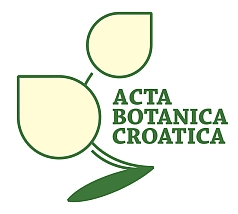First record of Diplotomma cedricola in the eastern Mediterranean
Introduction
Diplotomma cedricola (Werner) Etayo (=Buellia cedricola Werner) is a lignicolous specialist species growing on decorticated parts of conifer trunks in semi-open woodlands at elevations of 700 to 2400 m (Burgaz and Sarrión 1995, Bungartz et al. 2007). The known range of the species is extended to a few localities in the southwestern United States (Nordin 1999, Bungartz et al. 2007), Canary Islands (Nordin 2000, Giralt and van den Boom 2011) and western Mediterranean countries including the north of Morocco (Werner 1970, 1974), central-southern areas of Spain (Burgaz and Sarrión 1995, Aragón et al. 2004) and Corsica (France) (Werner and Deschatres 1974).
In this contribution, we present the first record of Diplotomma cedricola in Greece (Crete Island), significantly expanding the range of this species to southeastern Europe.
Materials and methods
Specimens were collected on 5th December 2022, in Selakano Forest, near the village of Selakano in Crete. The samples were deposited in the MACB Herbarium (Faculty of Biology, Complutense University of Madrid). To verify the identification, the collected specimens were compared with Spanish material (MA and MACB herbaria). The nomenclature follows Index Fungorum (www.indexfungorum.org). Habitat description is based on personal observations.
Localities of sampling: Greece: Crete Island, Iérapetra, Selakano, 35º05’06’’N, 25º31’10’’E, 1174 m a.s.l., on decorticated Cupressus sempervirens L., G. Aragón nº 1009 et al., December 5, 2022, MACB. Iérapetra, Selakano, 35º04’52’’N, 25º31’51’’E, 1080 m a.s.l., on decorticated Pinus brutia Ten., G. Aragón nº 1010 et al., December 5, 2022, MACB.
Results and discussion
Diplotomma cedricola is distinctive by its yellowish tinged thallus (usnic acid), K+ red (norstictic acid), black apothecia cryptolecanorine to adnate, and its submuriform to muriform spores (21-26 × 10-13 µm). A complete and detailed description of the species is available in Burgaz and Sarrión (1995) and Bungartz et al. (2007).
The species is found on decorticated and hardened parts of old Pinus brutia and Cupressus sempervirens trees, in mountain forests, at 1000-1200 m altitude (Fig. 1). The species appears only together with Lecanora varia (Hoffm.) Ach. Host tree species were similar to those previously reported for Diplotomma cedricola. In general, the species appears on a variety of mostly decorticated coniferous trees such as Cedrus atlantica (Endl.) Carrière in Morocco (Werner 1970), Juniperus L. (J. oxycedrus L., J. thuriferaL.) and Pinus spp. in southern Europe and the Canary Islands (Werner and Deschatres 1974, Nordin 2000, Aragón et al. 2004, Martínez et al. 2002) and Juniperus deppeana Steud. in North America but it has also been observed on Cupressus arizonica Greene and several species of Pinus (Nordin 1999).
Figure 1.
Fig. 1. A – Decorticated trunk of Cupressus sempervirens L., 1174 m a.s.l., Crete, is a typical habitat of Diplotomma cedricola(Werner) Etayo. Photo: L. Jiménez-Eguizábal. B – Diplotomma cedricola. Scale bar: 1.0 cm. Photo: G. Aragón.
The new locality situated in the east of Crete is composed of abrupt and unequal mountain landscape, where open forests are developed on limestone with intensive livestock management (goats). The dominant tree species are Pinus brutia and Cupressus sempervirens at medium altitudes, and Quercus coccifera L. at lower altitudes, while the vegetation of the ravines is composed mainly of Platanus orientalis L. and Nerium oleander L.
Diplotomma cedricola is reported here from SE Europe for the first time and its distribution area is now enlarged to Crete (Greece). This species was not reported in the recent checklist of Greek lichens (Arcadia 2022), the nearest known locality being situated in Corsica (France) (Burgaz and Sarrión 1995).
References
Aragón, G., Sarrión, F. J., Martínez, I., 2004: Epiphytic lichens on Juniperusoxycedrus L. in the Iberian Peninsula. Nova Hedwigia 78(1–2), 45–56. https://doi.org/10.1127/ 0029-5035/ 2004/0078-0045
Arcadia, L. 2022. The lichens of Greece. Retrieved December 12, 2022 from https://www.lichensofgreece.com/index.html
Bungartz, F., Nordin, A., Grube, U., 2007: Buellia. In: Nash III, Th. H., Gries, C., Bungartz, F. (eds.), Lichen Flora of the Greater Sonoran Desert Region, vol. 3, 113–178. Lichens Unlimited, Arizona State University, Tempe, Arizona.
Burgaz, A. R., Sarrión, F. J., 1995: Buelliacedricola new to Europe. Lichenologist 27(4), 305–308. https://doi.org/10.1006/lich.1995.0027
Giralt, M., van den Boom, P. P. G., 2011: The genus Buellia s.l. and some additional genera of Physciaceae in the Canary Islands. Nova Hedwigia 92(1–2), 29–55. https://doi.org/10.1127/0029-5035/2011/0092-0029
Martínez, I., Aragón, G., Burgaz, A. R., 2002: Epiphytic lichens and lichenicolous fungi from the ’Serranía de Cuenca’ mountains (’Sistema Ibérico’, Spain). Herzogia 15, 37–49. https://doi.org/10.1127/herzogia/15/2002/37
Nordin, A., 1999: Buellia species with pluriseptate spores: new and unrecorded species in North America. The Bryologist 102(2), 249–264. https://doi.org/10.2307/3244364
Nordin, A., 2000: Taxonomy and phylogeny of Buellia species with pluriseptate spores (Lecanorales, Ascomycotina). Symbolae Botanicae Upsaliensis 33, 1–117.
Werner, R. G., 1970: La flore lichénique des chènes à liège et des cèdres. Bulletin de la Société Mycologique de France 86(4), 813–830.
Werner, R. G., 1974: Flore lichénologique du Moyen Atlas central. Bulletin de la Société Mycologique de France 90(1), 49–66.
Werner, R. G., Deschatres, R., 1974: Contribution à l´étude des lichens de la Corse. III. Bulletin de la Société Botanique de France 121, 299–318.

